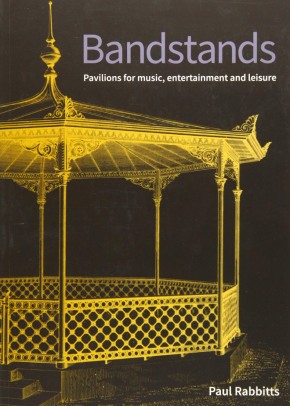Bandstands: pavilions for music, entertainment, and leisure
‘Bandstands: pavilions for music, entertainment, and leisure’, Paul Rabbitts, Historic England, 248 pages, 244 colour illustrations, softback.
Anyone who expects merely a celebration of the familiar cast-iron bandstand, an example of which graces the front cover of this book, will find it to be far more. It is a study of open-air music and its links with private pleasure gardens, the development of 19th and 20th century parks, and the expansion of seaside resorts as places of entertainment and leisure. Published by Historic England, with the aid of 111 supporters, its academic credentials are established by a comprehensive index and gazetteer of both existing and lost bandstands with dates, manufacturer or foundry, full bibliography and extensive notes.
The early chapters review leisure in private pleasure gardens and move to the ‘rational recreation’ of public parks and the place of music within them. Surprisingly, it was the sounding boards of bandstands that were important in amplifying northern brass bands and those of the military to increase public appreciation of music in parks. A further chapter deals with the varied art and architecture of bandstands, not only the familiar cast and wrought iron so excoriated by Ruskin and Mawson, but also to those of arts-and-crafts influence, such as that at Rushdene in Nottinghamshire by Sir Albert Richardson.
From there Rabbitts notes the post-war decline through changing musical taste and lack of local authority maintenance. He records the change in attitude to parks in the late 20th century, and the numerous restorations and replacements of bandstands fostered by the Heritage Lottery Fund. The book finishes positively with the array of uses for bandstands as focal points for our restored and vibrant parks.
A brief recital of the book’s coverage gives little indication of the treasures to be found within. There are wonderful and varied historic and modern photos of the bandstands (including shells) in use. Drawing on contemporary commentators, there is considerable detail on events up and down the country, which lauds the variety of musical entertainment as seen through the eyes of citizens. A book for savouring, it will repay close reading for a wider historical understanding of the place of music in entertainment and leisure, and its role in the democratic nature of public parks.
Cast-iron enthusiasts will sift through a treasury of varied designs by Macfarlanes and the other Scottish foundries of the central belt. They exported their wares to the Commonwealth and the new world, thus promoting globally British ideas of music and its favoured place in public parks.
This article originally appeared as ‘Rational recreation’ in IHBC's Context 163 (Page 54), published by The Institute of Historic Building Conservation in March 2020. It was written by GR Arnold, retired Wirral conservation officer.
--Institute of Historic Building Conservation
Related articles on Designing Buildings Wiki
IHBC NewsBlog
Old Sarum fire in listed (& disputed) WW1 Hangar - Wiltshire Council has sought legal advice after fire engulfed a listed First World War hangar that was embroiled in a lengthy planning dispute.
UK Antarctic Heritage Trust launches ‘Virtual Visit’ website area
The Trust calls on people to 'Immerse yourself in our heritage – Making Antarctica Accessible'
Southend Council pledge to force Kursaal owners to maintain building
The Council has pledged to use ‘every tool in the toolbox’ if urgent repairs are not carried out.
HE’s Research Magazine publishes a major study of the heritage of England’s suburbs
The article traces the long evolution of an internal programme to research 200 years of suburban growth
IHBC Context 183 Wellbeing and Heritage published
The issue explores issues at the intersection of heritage and wellbeing.
SAVE celebrates 50 years of campaigning 1975-2025
SAVE Britain’s Heritage has announced events across the country to celebrate bringing new life to remarkable buildings.
IHBC Annual School 2025 - Shrewsbury 12-14 June
Themed Heritage in Context – Value: Plan: Change, join in-person or online.
200th Anniversary Celebration of the Modern Railway Planned
The Stockton & Darlington Railway opened on September 27, 1825.
Competence Framework Launched for Sustainability in the Built Environment
The Construction Industry Council (CIC) and the Edge have jointly published the framework.
Historic England Launches Wellbeing Strategy for Heritage
Whether through visiting, volunteering, learning or creative practice, engaging with heritage can strengthen confidence, resilience, hope and social connections.
















